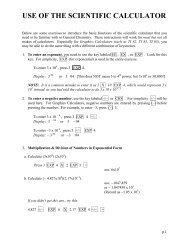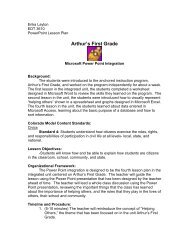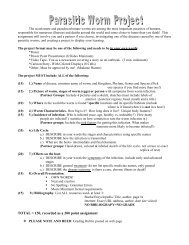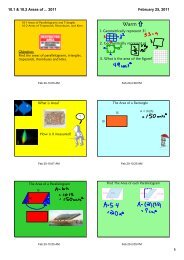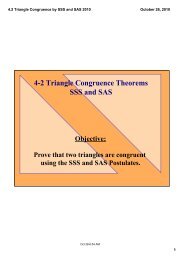Colligative Properties PowerPoint
Colligative Properties PowerPoint
Colligative Properties PowerPoint
- No tags were found...
You also want an ePaper? Increase the reach of your titles
YUMPU automatically turns print PDFs into web optimized ePapers that Google loves.
<strong>Colligative</strong> <strong>Properties</strong>The Physical <strong>Properties</strong> ofSolutions
<strong>Colligative</strong> <strong>Properties</strong>• There are 3 colligative or physicalproperties of solutions that you shouldknow. They are1. Vapor pressure2. Boiling point elevation3. Freezing point depression4. Osmotic pressure is one you don’tneed to worry about.
Molality• Molality measures the moles of solutedissolved in the mass (kg) of solvent.• Molality normally expressesconcentrations of colloids.• m = moles solutekg solvent
Molality• Example:A 0.5 mole solute is prepared in 1 Kg ofwater. What is the molality of thesolution?0.5 moles = 0.5 molal1 Kg of H 2 O
Molality• Example:What is the molality of a solutionprepared by dissolving 8.87 g ofmethanol CH 3 OH, in 20.0 g of water?Calculate the moles of solute (CH 3 OH)8.87 g = 0.277 mol32.04 g
MolalityCalculate the molalitym = 0.277 mol CH 3 OH x 1000 g solvent20.0 g H 2 O 1 Kg solvent= 13.8 m
Molality• Determine the molality of 3000 g ofsolution containing 37.3 g of KCl.37.3 g KCl = 0.5 moles KCl74.6 g
Molality• Determine the grams of pure solvent.Total = mass of solute + mass of solvent3000 g = 37.3 g + mass of solvent3000 g – 37.3 g = 2962.7 g of solvent
Molality• Convert grams of solvent to kilograms2962.7 g x 1 Kg = 2.9627 Kg1000 g• m = 0.5 moles = 0.169 m2.9627 Kg
Changes in Vapor Pressure• Nonvolatile solutes always lower thevapor pressure of a solution.• Vapor pressure (VP) is the result ofevaporating solvent.• VP depends on temperature.• In a closed container, VP reaches aconstant level at any given temperature.
Changes in Vapor Pressure• Animation showing how VP isestablished.• Animation showing how VP is affectedby temperature.• How does a solute affect VP?
Changes in Vapor Pressure• Solvent moleculesmust be at thesurface of the liquidto evaporate.• A surface moleculegets bumped frombelow and is“launched” into thevapor phase.
Solution Vapor Pressure• But what happens tothe chance of asolvent moleculeescaping if there aresolute particles inthe solution?• The red soluteparticles reduce thechances of escape.• Thus, VP is lower forthe solution.
Changes in Boiling and FreezingPoints• The presence of solute particles affects theboiling and freezing points of a liquid.• Boiling point is always increased (boilingpoint elevation.)• Since the vapor pressure is lower to start, theliquid must be hotter for the vapor pressure toequal the pressure of the gas above theliquid.
Boiling Point Elevation• There is a simple formula for calculating thechange in boiling point.• ΔT b = k b m• ΔT b is the change in the boiling temp., addedto the liquid’s original BP.• k b is the ‘molal boiling point constant’ whichdepends on the solvent. For water, k b is0.51°C/molal• m is the molality of the solution.
Freezing Point Depression• Solution freezing points are always lowerthan that of the solvent liquid.• A similar formula is used to calculate thechange in the freezing point.ΔT f = k f m• ΔT f is the change in the freezing temp.,subtracted from the liquid’s original FP.• k f is the ‘molal freezing point constant’ whichdepends on the solvent. For water, k f is1.86°C/molal• m is the molality of the solution.
Freezing Solutions• Solutions typically do not freeze solidly.• Pure solvent crystals freeze from themixture, turning it slushy.• The solution that remains is moreconcentrated, dropping the freezingpoint even further.• Finally a matrix of solid solvent withpockets of highly concentrated solutionresult.
Freezing Solutions• A good example of a“frozen solution” is apopsicle.• What happens to apopsicle if you suckon it?• Right! A very sweetliquid comes out,and all you have leftis a tasteless stick ofwater ice.
Practical Applications• Antifreeze in your car’s radiator makesuse of a solution to both drop thefreezing and raise the boiling point.• Antifreeze is a solution of ethyleneglycol (an alcohol) and water.• It prevents the liquid in the coolingsystem from freezing and cracking theengine block.• It also prevents the liquidfrom boiling over whenthe engine is hot.
Practical Applications• One of my favorite applications involvingfreezing point depression is making icecream.• The ice cream mix is milk, cream and sugar.• Around the ice cream container is a mix ofwater ice and rock salt.• The ice/salt mix gets colder than the freezingpoint of the ice cream mixture.
The van’t Hoff Factor• We have learned that when ionic solids(or any electrolyte) dissolve in water,they split up into multiple parts.• CaCl 2 (s) Ca 2+ (aq) + Cl - (aq) + Cl - (aq)• 1 molecule 3 ionic particles• <strong>Colligative</strong> properties depend on theconcentration of dissolved particles, notwhat kind of particles they are.
The van’t Hoff Factor• Since 1 mole of an electrolyte produces2, 3, 4 or even 5 dissolved particles,these substances have 2, 3, 4 or even 5times the effect on freezing and boilingpoints as non-ionizing solutes.• Thus we make an adjustment to ouroriginal equations for calculating theboiling and freezing point changes.
The van’t Hoff Factor• ΔT b = k b m i• ΔT f = k f m i• i = the van’t Hoff factor. Simply find thenumber of ions produced when thesubstance dissolves and put it into theequation.• Animation of NaCl dissolving in solution.
A Practical Example• NaCl(s) Na + + Cl - 2 ions so i = 2.• Calculate the BP of a solution of 59g ofNaCl in 1 kg of water.• m = 59g NaCl/1 kg = 1 molal sln• ΔT b = k b m i = 0.51°C/m (1 m) 2 =1.02°C• The new BP is 100°C + 1.02°C = 101°C• Think about that the next time you addsome salt to the pot of water you wantto boil.
Heat of Solution• Most materials either absorb or give offheat energy when they dissolve in aliquid. They undergo an enthalpychange.• Enthalpy (ΔH) is the internal energy of asystem.• For example, when NH 4 Cl dissolves, itabsorbs heat from the water, making acold solution.• NH 4 Cl has a positive heat of solution.
Heat of Solution• That probably seems backwards, sincethe temperature is going down.• But think of it this way. Adding energymakes the solute dissolve better.• NH 4 Cl(s) + heat NH 4 Cl(aq)• The system absorbs heat and goesuphill energetically.
Endothermic Heat of SolutionNH 4 Cl(aq)ΔHChange inenthalpyUphill means ΔHis positive.NH 4 Cl(s)Time
Exothermic Heat of Solution• Other materials, like CaCl 2 , release heatas they dissolve.• The released energy makes the solutionwarmer.• Since the dissolving process loses heat,the system is going downhillenergetically, and ΔH is negative.
Exothermic Heat of SolutionCaCl 2 (s)ΔHChange inenthalpyDownhill meansΔH is negative.CaCl 2 (aq)Time
Practical Applications• Road de-icer is a solution of MgCl 2 or CaCl 2 .• Both have a van’t Hoff factor of 3, thuslowering the freezing point of the water on theroad considerably.• The outdoor temperature mustbe substantially colder for thesolution to refreeze.• CaCl 2 also has an exothermic heat ofsolution, which helps melt the ice in the firstplace.
Calculating Heat Exchange• A simple formula is frequently used tocalculate heat change in a substance.• ΔH = mcΔT• ΔH is the change in internal energy(heat change). + ΔH = endothermic,- ΔH = exothermic.• m = mass of the substance changingtemperature.
Calculating Heat Exchange• c = specific heat capacity of thesubstance.• ΔT = the change in temperature of thesubstance.• Example: 50.0g of water warms by4.6°C as a salt dissolves in it.• How much heat has been released?
Calculating Heat Exchange• The specific heat of water is 4.18 J/g°C.• In other words, it takes 4.18 J of energyto make 1 g of water warm up by 1°C.• Calculating the heat change:• ΔH = 50.0g(4.18 J/g°C)4.6°C• = 960 J of heat.
Practical Applications• Medical kits often contain bags thatwhen struck hard and shaken get veryhot or very cold, as if by magic.• It’s not magic, it’s a demonstration ofheat of solution.



